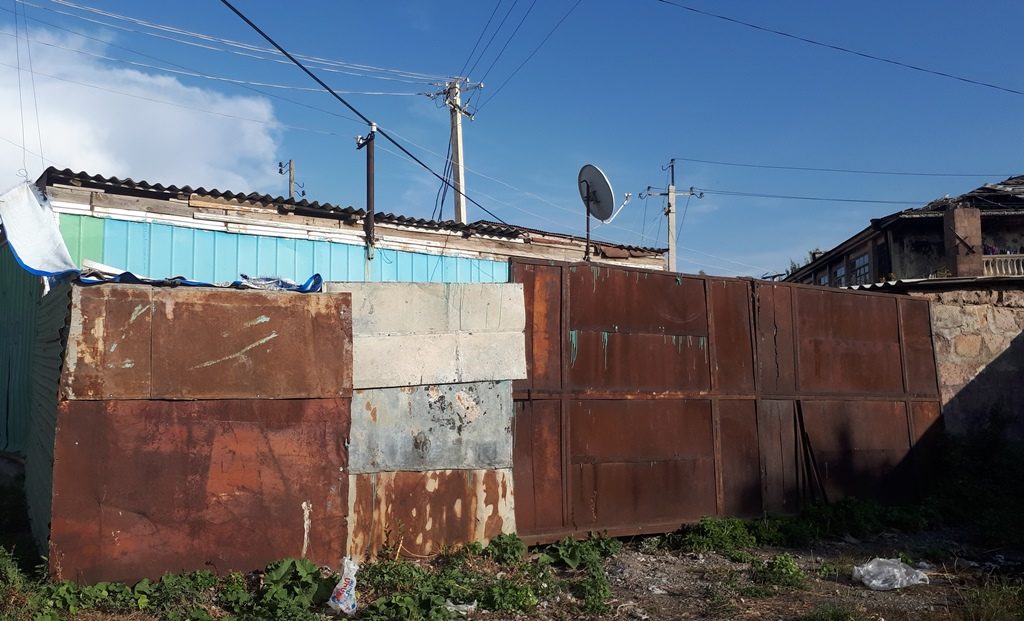

Almost a million Armenians live below the national poverty, around a third of the country. For over two decades successive governments have promised— and failed — to tackle poverty; following the Velvet Revolution, Pashinyan’s government has promised the same.
Sixty-year-old Gayane, a resident of Yerevan, begins her day digging through bins looking for food, clothing, and items that can be recycled.
‘For 5 years I’ve been working like this. I have no other way to support my family. I have an ill husband and daughter who do receive financial support from the state, but it’s a very small amount of money. With this money, I can barely afford their medicines, and if a little is left, it will pay for part of the utility bills. But we need to eat’, Gayane says.
She starts her working day early in the morning. She says many people throw out their rubbish before going to work. There are also relatively few people on the streets so she will not be noticed so much — though she is already used to this lifestyle.
‘I used to be very ashamed, but we had no other choice. We stayed hungry for days. I tried to find a job in many places, but nobody took me. One said I wasn’t young, wasn’t fit for work, another said that I wasn’t pretty.’
‘My health is ruined, unfortunately I cannot do physical work for long periods of time, I start to suffocate, otherwise I would clean the streets or go to work in the market as a porter.’
Today, Gayane goes out into the street with almost her entire body covered. She also wears a hat. She says she is trying to make herself as unrecognisable as possible.
‘When my husband was healthy, when we were young, we lived a pretty good life. We never went hungry or had no clothes to wear, or owed money, but now we have become miserable.’
‘Gradually, many people seem to have fallen into poverty. In the past, a lot of useful things could be found in the rubbish, but not now’, says Gayane, comparing between the things she would find five years ago and today.
‘When I started working like this, I very often found clothes that were not too worn out, that we could easily wear, but now I don’t find clothes so often, or when I find them, they are mainly worn-out.’
‘In the past, many people would leave a separate bag of bread and leftover food next to the bin, probably for people like us or for the stray dogs and cats, now these bags have become rarer. It seems not so many people are able to buy enough food anymore, let alone to leave food for us.’
‘I also used to find dozens of glass containers in the past, which I washed and handed in to the container pick-up points. Gradually their number declined. People prefer to hand in these bottles themselves and not to throw them away; though it’s negligible, it is a source of money.’
A half-percent victory
According to the latest available figures from Armenia’s national statistics office, from 2015–2016 the government recorded a half-percent victory in reducing poverty, from 29.8% to 29.4%.
This still put almost one in three Armenians below the national poverty line, consuming less than the family basket of ֏48,000 ($99), which the government claims is the minimum needed to meet basic needs.
According to economist Tigran Keyan, these numbers do not always show the real image.
‘All the businessmen submit approximate reports to the [National Security Service] which are very far from reality. Even if all the numbers were correct, the ֏48,000 calculated as the average consumer basket is not enough for a person to care for their needs.’
‘One of the basket pricing indicators is the price of commodity goods. Very often, the prices with which the calculations are made have nothing to do with the real market price. Everything is more expensive in the market’, says Keyan.
According to Keyan, there is a section of Armenia’s population that survives only through remittances from abroad. Since there is no statistical data in this regard, it is not possible to clearly indicate what percent of the population uses these transfers, Keyan says it is a banking secret.
The poorest of all times
After a devastating earthquake in 1988, Shirak Province became the poorest province in Armenia; almost half the population lives below the national poverty line here. And poverty in Shirak is deepening — in 2014, 44% of people lived below the poverty line, in 2016, this figure was 45.5%.
‘I don’t even remember the last time I ate fully’, says 35-year-old Anna from Gyumri. ‘I’m not even speaking about eating meat; this is a luxury we can afford just once a year, for the New Year’s holidays’.
Anna prefers not to talk about her life much. She says she has been living in a shelter since she was five. She spent her childhood in a damp shelter with no utilities, then got married and moved to a neighbouring shelter, which was in no way an improvement.
‘I don’t even know what it means to sleep in a dry, warm house; I’m used to the mildew on the walls of the shelter, the rotten floor and roof, I’m used to doing laundry by hand, carrying water.’
‘I don’t even think about myself, I just worry about my small children; they opened their eyes in this shelter and I’m afraid they’ll grow up here too’.
Anna’s husband left to work abroad for the first time this year. The money he sends back every month is barely enough to cover Anna’s and the children’s minimum needs.
‘He sends about $200 a month. I pay utility bills with this money, pay my debts accumulated over the years, and with what’s left, I can hardly afford food’.
Most of the clothes Anna and the children wear were donated by relatives, and are mostly second hand.

‘I’ve probably never had new clothes in my life’, Anna says. ‘I’ve always worn old clothes given to me by somebody. Even on my wedding, I wore my cousin’s wedding dress and put on her shoes.’
‘Now when my husband sends money, I try to buy at least the most affordable clothes for my children. Well, they are still little, 2 and 4 years old, but I don’t want anybody to point at them in the street, saying: “look, look, they have no normal clothes, they wear worn-out ones”. ’
Several times Anna has received offers to be filmed for various social programmes, but she was always against it; she does not want to earn money this way.
‘They come and offer to photograph me, invite me to talk shows, but I don’t go. I tell them to write down the story of my life, but not photograph me and my children. I don’t want our faces to be labeled as poor, miserable.’
‘Maybe when my children grow up, they will receive a good education, find a good job, I don’t want them to take videos and photos from the archives that will remind them of these difficult years.’
‘Most of the city’s population is hungry like us. Gyumri has become an open platform for filming; everyone comes to shoot us, publicising video clips to collect large audiences, or making big promises during the election just to forget us after being elected.’
Anna says she is no longer able to imagine that a day will come when they will be fully fed, warm, and will not worry about paying their debts.
Broken promises and new expectations
Every government of Armenia has pledged to fight poverty. When Tigran Sargsyan was appointed Prime Minister in 2008, his government pledged to tackle the problem in short order. But by 2012, the number of people below the poverty line had risen from 28% to 32%.
When in 2012 Sargsyan presented the government’s programme for 2012–2017, it included a promise to decrease the poverty rate by about 10%.
He resigned in 2014, his promise unfulfilled, and Hovik Abrahamyan was appointed Prime Minister making the same promises.
In 2016, Abrahamyan left the post, with the poverty rate reduced by just 2%.
When Karen Karapetyan was appointed Prime Minister, the government promised to reduce the poverty rate by 12% by 2022. But in 2018, Karapetyan also left the post.Nikol Pashinyan was swept to power in May after leading weeks of street protests against the government in what has been dubbed the ‘Velvet Revolution’. Just like his predecessors, Pashinyan’s new government again promised to fight poverty, but did not give any numerical pledges.
[Read on OC Media: Fiery revolutionary or pragmatic politician: what to expect from Nikol Pashinyan]

‘The government is convinced that the non-violent, velvet, people’s revolution in Armenia in April–May of 2018, caused positive economic and investment expectations. In the conditions of political stability, positive expectations will most likely turn into a flow of investment, and the government intends to direct investments to the regions and encourage investments aimed at creating new jobs’, the government programme states.
According to Pashinyan, the government is discussing simplifying the Tax Code and reducing income tax, as well as overhauling the pension system to achieve this.
With Pashinyan’s My Step bloc widely expected to win December’s snap elections, only time will tell if this latest government may finally make a dent in Armenia’s poverty.
This article was prepared with support from the Friedrich-Ebert-Stiftung (FES) Regional Office in the South Caucasus. All opinions expressed are the author’s alone, and do not necessarily reflect the views of FES.








